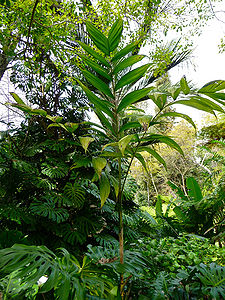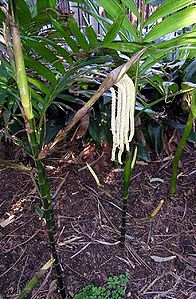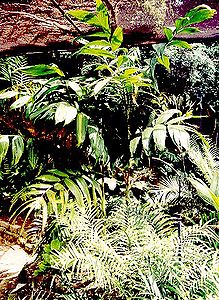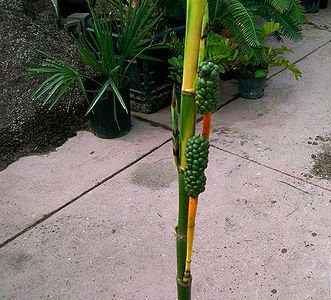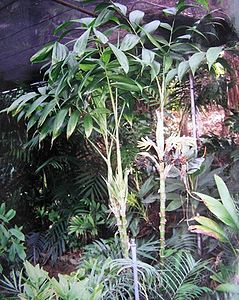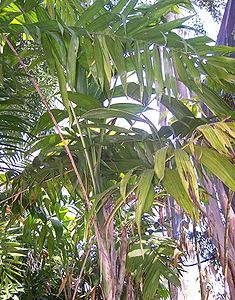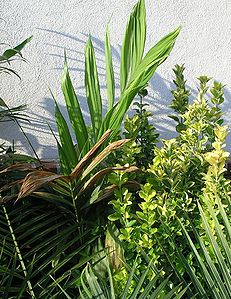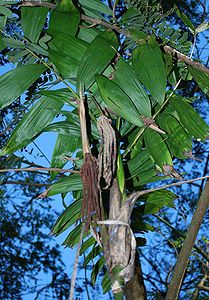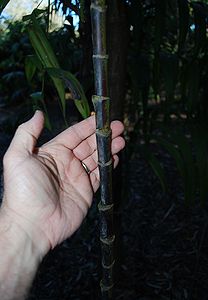Chamaedorea arenbergiana
<google>CH02</google>
| Chamaedorea (kam-ee-DOR-ee-ah) arenbergiana (ah-ren-burg-ee-AY-nuh) | |||||||
|---|---|---|---|---|---|---|---|
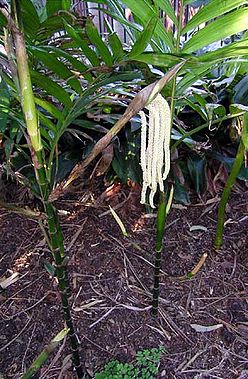 Photo by Ian Edwards, edric. | |||||||
| Scientific Classification | |||||||
| |||||||
| Synonyms | |||||||
|
| |||||||
| Native Continent | |||||||
|
| |||||||
| Morphology | |||||||
| |||||||
| Culture | |||||||
|
| |||||||
| Survivability index | |||||||
|
| |||||||
| Common names | |||||||
|
| |||||||
Contents
Habitat and Distribution
MEXICO. Chiapas. Oaxaca. Veracruz. GUATEMALA. Alta Verapaz. Baja Verapaz. Huehuetenango. San Marcos. HONDURAS. Atlantida. EL SALVADOR, NlCARAGUA, COSTA RICA, PANAMA, and COLOMBIA. Moist or wet forest on the Atlantic and Pacific slopes; alt. 100-1,500 m elevation.
Description
Trunk type: Solitary, hosts dark green rings from leaf scars, when mature. Hight: To approximately 4 meters, (13'). Leaf detail: Leaves on young palm are v-shaped, mature leaf is pinnately compound, alternately apposed, widely spaced, dark green, rather wide, ovoid pinnae, to 15 centimeters, (6") long, Flower detail: Inflorescence is green. Has a dark green, ringed trunk, which has leaflets up to 15cm across, and an infructescence that looks like a green corn-on-the-cob. Similar in appearance to a small C. tepejilote , altho this species has much wider leaflets.
Habit: solitary, erect, rarely decumbent, to 4 m tall, sometimes flowering when stemless. Stem: 2-3 cm in diam. green, ringed, internodes 5-15 cm long. Leaves: 4-6 per crown, erect-spreading, pinnate, to 2-2.5 m long; sheath 30-45 cm long, obliquely open apically, auriculate; petiole 35-45 cm long, obtusely triangular, faintly channeled and green above, rounded and pale below; rachis 1-1.25 m long, angled and green above, rounded below with a pale band extending onto sheath; pinnae 8-10 on each side of rachis, largest ones 60 x 15 cm, rather elongate-oblong or oblong-lanceolate, sigmoid, ± falcate, well spaced, very long-acuminate and drooping apically, contracted basally, 5-8 prominent primary nerves keeled above, shining and yellowish below, numerous nerves of lesser orders present. Inflorescences: infrafoliar, solitary, erect in flower, spreading or nodding in fruit; peduncles 15-20 cm long, ± stout, 1-1.5 cm in diam., green in flower, red-orange in fruit; bracts 5-6, fibrous, loosely sheathing, greenish brown or brown in flower often becoming tattered, longitu mally striate-nerved, upper ones exceeding peduncle. Staminate with rachis 3 cm long, pale in flower; rachillae 8-10, these 12-15 cm long, 8 mm diam., pendulous, pale in flower. . Pistillate spicate or forked; rachis or flower-bearing portion 6-15 cm long, 1.5 cm or more in diam., orange and swollen in fruit. Flowers: Staminate in 6 dense spirals, contiguous in bud, 3 x 3.5-4 mm, depressed-globose, angled from mutual pressure, cream-colored to brownish white, ± superficial; calyx higher than petals and enclosing them in bud, 1.5 x 4 mm at anthesis, shallowly lobed, sepals connate nearly to apex, forming a sheathing tube, ± straight apically; corolla adnate with stamen filaments and pistillode in a very short basal stipe, petals 3.5-4 x 3 mm, broadly ovate, imbricate in basal 1/3-1/2, valvate and free apically, spreading, erect, rounded to acute, ± thick; stamens equalling petals, clear- or cream-colored, filaments prominent, distinct, anthers divaricate basally; pistillode 3.5-4 mm tall, equalling stamens and petals, columnar, apically 3-lobed, cream-colored. Pistillate very densely crowded in perhaps as many as 20 rows and ± sunken in axis; calyx nearly as high as petals, shallowly lobed, membranous, sepals connate nearly to apex, rounded to straight apically; petals imbricate nearly to apex, short-pointed; staminodes lacking; pistil ovoid, 3-lobed, stigma lobes sessile, short, recurved. Fruits: 12 x 19 mm, subglobose or transverse-oblong, densely packed, angled from mutual pressure, black; seeds 10-12 x 9-10 mm, oblong; abortive carpels usually separating from fruit and adhering to perianth. Editing by edric. (Hodel, D.R. 1992)
Apparently introduced to European gardens prior to 1850, Wendland (1854) described and named C. arenbergiana from plants cultivated in the gardens of the Duke d'Arenberg-Nieppen in Belgium. Wendland was unsure of its provenance, but tentatively listed its origin as Guatemala. According to Guillaumin (1923b), it was cultivated at the Musee de Paris in France as early as 1862 as C. densiflora. Chamaedorea arenbergiana occurs in moist and wet forest from Mexico through Guatemala, Honduras, and perhaps El Salvador and even further south in Central America and into northern South America. Some of the collections tentatively identified as C. arenbergiana which have extended its range to Costa Rica and Colombia are perhaps C. allenii, C. crucensis, or closely related, yet unnamed, taxa. Part ofthe difficulty in distinguishing between C. arenbergiana and related taxa (and thus establishing their true ranges) is that staminate material, which is critical for diagnosis, is infrequently found since it is fragile and deteriorates quickly. When only fruiting material is at hand, which is most often the case, diagnosis is difficult at best. I have yet to be able to establish diagnostic characters based only on foliage or fruiting material. C. arenbergiana is probably closest to C. nationsiana but the multiple, spicate staminate inflorescences distinguish this latter species. Chamaedorea arenbergiana is an attractive ornamental with large, handsome leaves, densely flowered, spicate or forked inflorescences, and corncoblike infructescences. It always draws attention in the garden when heavily laden with densely packed, black fruits. Pinnae of C. arenbergiana can be up to 15 cm wide, making them among the widest in the genus. C. arenbergiana is cultivated in Hawaii, California, Florida, Australia, and perhaps elsewhere. (Hodel, D.R. 1992)
Culture
Requirements: This is an understory palm. It has no wind tolerance, near full shade when young, heavily filtered light when mature, consistently moist soil, well drained position. Often grown more than one per container. Warm, sheltered and moist.
Comments and Curiosities
Chamaedorea are dioecious, male, and female flowers, on separate plants.
Etymology: Honors the Duke d'Arenberg- Nieppen, from whose garden the type originated.
External Links
References
Phonetic spelling of Latin names by edric.
Special thanks to Geoff Stein, (Palmbob) for his hundreds of photos, edric.
Special thanks to palmweb.org, Dr. John Dransfield, Dr. Bill Baker & team, for their volumes of information and photos, edric.
- IMAGE GALLERY
Many Special Thanks to Ed Vaile for his long hours of tireless editing and numerous contributions.


